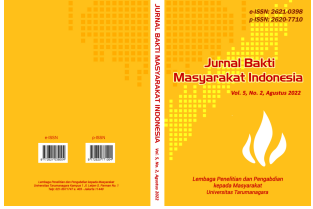PEMBINAAN PRODUKSI DAN BISNIS TEMPE MASYARAKAT DESA CIBOGO, CISAUK-TANGERANG
Main Article Content
Abstract
Tempe is a fermented food from Indonesia. However, certain people still have a limited understanding of tempeh as a healthy food. In addition, how to produce hygienic tempe and how the potential of tempe as a family business is still limited. Cibogo Village is a location in the District of Cisauk-Tangerang. In Cibogo there is no tempe production business, and the people's understanding of tempe food is still very limited. Therefore, this activity aims to increase public knowledge about tempe as healthy food and how to make it hygienic. This community service activity is carried out using counseling, demonstration, and mentoring methods. Monitoring was carried out to measure the success rate of participants in producing healthy tempeh. Participants' perceptions of tempeh were evaluated through a survey method, and the increase in knowledge was measured through tests (pretest and posttest). The counseling, demonstration, and mentoring results improved the participants' skills, as seen in their success in making tempeh. The survey results showed increased participants' knowledge about tempeh as a healthy food. The participants have also been able to produce healthy tempeh independently. The survey results also show that the activities carried out benefit them. The facilitator's ability to deliver the training materials was considered reasonable by the participants. Several participants are interested in increasing this activity to produce tempe for a business scale further
ABSTRAK
Tempe merupakan makanan fermentasi asal Indonesia. Namun, masyarakat tertentu masih terbatas pemahamannya tentang tempe sebagai makan yang sehat. Selain itu, bagaimana cara memproduksi tempe yang higienis dan bagaimana potensi tempe sebagai bisnis keluarga masih terbatas. Desa Cibogo merupakan satu lokasi yang berada di Kecamatan Cisauk-Tangerang. Di Cibogo belum ada usaha produksi tempe dan pemahaman tentang makanan tempe masih sangat terbatas. Oleh karena itu, kegiatan ini bertujuan untuk meningkatkan pengetahuan masyarakat tentang tempe sebagai makanan sehat dan cara pembuatannya higienis. Kegiatan pengabdian masyarakat yang dilakukan dalam menggunakan metode penyuluhan, demonstrasi, dan pendampingan. Monitoring dilakukan untuk mengukur tingkat keberhasilan peserta dalam memproduksi tempe sehat. Persepsi peserta tentang tempe diukur melalui metode survei dan peningkatan pengetahuan melalui tes (pretest dan posttest). Hasil penyuluhan, demonstrasi, dan pendampingan berhasil meningkatkan keterampilan para peserta terlihat dari keberhasilan mereka dalam membuat tempe. Hasil survei menunjukkan adanya peningkatan pengetahuan peserta tentang tempe sebagai makanan sehat. Para peserta juga telah dapat memproduksi tempe sehat secara mandiri. Dari hasil survey juga menunjukkan bahwa kegiatan yang dilakukan sangat bermanfaat bagi mereka. kemampuan fasilitator dalam menyampaikan materi pelatihan yang dinilai baik oleh para peserta. Ada beberapa peserta yang berminat untuk meningkatkan kegiatan ini untuk lebih lanjut memproduksi tempe untuk skala bisnis
Article Details

This work is licensed under a Creative Commons Attribution-NonCommercial-ShareAlike 4.0 International License.
This work is licensed under a Jurnal Bakti Masyarakat Indonesia https://creativecommons.org/licenses/by-nc-sa/4.0/
References
Aryanta IWR. 2020. Manfaat Tempe Untuk Kesehatan. Widya Kesehatan. 2(1): 44-50.
Astawan, M., Wresdiyati, T., Maknun, L. 2017. Tempe sumber zat gizi dan komponen bioaktif untuk kesehatan. IPB Press, Bogor
Barus T., Suwanto A., Wahyudi A., Wijaya H. 2008. Role of bacteria in tempe bitter taste formation: microbiological and molecular biological analysis based on 16S rRNA gene. Microbiol Indones 2:17-21. http://dx.doi.org/10.5454/ mi.2.1.4
Barus, T., Halim, R., Hartanti, A.T. And Saputra, P.K., 2019. Genetic diversity of Rhizopus microsporus from traditional inoculum of tempeh in Indonesia based on ITS sequences and RAPD marker: Genetic diversity in Rhizopus microsporus. Biodiversitas Journal of Biological Diversity, 20(3), pp.847-852.
Barus, T., Titarsole, N.N., Mulyono, N., Prasasty, V.D. 2019. Tempeh antioxidant activity using DPPH method: Effects of fermentation, processing, and microorganisms. Journal of Food Engineering and Technology 8(2):75-80. DOI:10.32732/jfet.2019.8.2.75.
Handajani, Y.S., Turana, Y., Yogiara, Y., Widjaja, N.T., Sani, T.P., Christianto, G.A.M. and Suwanto, A., 2020. Tempeh consumption and cognitive improvement in mild cognitive impairment. Dementia and geriatric cognitive disorders, 49(5), pp.497-502.
Lo, D., Romulo, A., Lin, J.Y., Wang, Y.T., Wijaya, C.H. and Wu, M.C., 2022. Effect of different fermentation conditions on antioxidant capacity and isoflavones content of soy tempeh. AIMS Agriculture and Food, 7(3), pp.567-579.
Magdalena, S., Hogaputri, J.E., Yulandi, A. and Yogiara, Y., 2022. The addition of lactic acid bacteria in the soybean soaking process of tempeh. Food Research, 6(3), pp.27-33.
Nout, M.J.R., Rombouts, F.M. 1990. Recent developments in tempe research. Journal of Applied Bacteriology 69:609-633. DOI:10.1111/j.1365-2672.1990.tb01555.x
Roubos van den Hill, P.J., Nout, M.J.R., Beumer, R., Meulen, J., Zwietering. 2009. Fermented soya bean (tempe) extracts reduce the adhesion of enterotoxigenic Escherichia coli to intestinal epithelial cells. Journal of Applied Microbiology 106:1013-1021. DOI:10.1111/j.1365-2672.2008. 04068.x.
Sarkar, F.H., Li, Y. 2002. Mechanisms of cancer chemoprevention by soy isoflavone genistein. Cancer Metastasis Reviews 21(4):265-280. DOI:10.1023/a:1021210910821.
Stephanie, T.S., Kartawidjajaputra, F., Silo, W., Yogiara, Y., Suwanto, A. 2019. Tempeh consumption enhanced beneficial bacteria in the human gut. Food Research 3(1): 57-63. DOI:10.26656/fr.2017.3(1).



